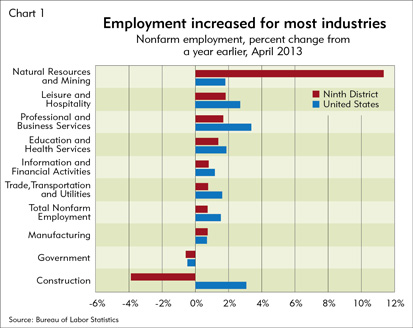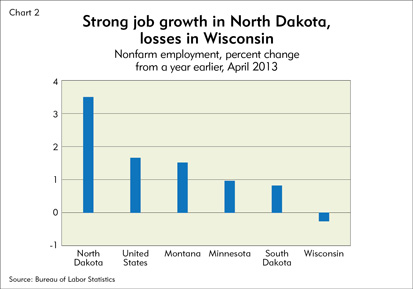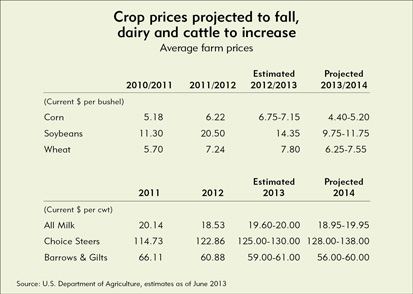The district economy continues to move forward at a moderate pace that is expected to continue through 2014, according to the Minneapolis Fed’s forecasting models and professional business services survey.
Stronger home building and rising home prices have supported the overall expansion, but have been counterbalanced by sluggish economies in Europe and China and fiscal concerns at the federal level. The Minneapolis Fed’s forecasting model results are less optimistic than predictions made six months ago, but overall employment and personal income are expected to grow modestly through 2014.
2013 started with moderate growth
The national economy started the year with moderate growth. Gross domestic product grew at an annual rate of 2.4 percent during the first quarter after increasing 2.2 percent during 2012. The national economy has also added a monthly average of 200,000 jobs over the past six months. While still down 2.4 million jobs from a peak in January 2008, the recent pace of job growth is consistent with rising output.
Consumer spending has continued to increase despite a rollback of payroll tax cuts at the beginning of the year and is supported by recent gains in home and stock market prices, which give consumers more confidence in their financial position. Household net worth was still down 5 percent in the first quarter of 2013 compared with levels prior to the recession when accounting for inflation. Nevertheless, household finances are in much better shape after household net worth dropped more than 20 percent from 2007 to 2008.
Employment in the district grew somewhat slower than in the nation during the first part of 2013, except in North Dakota and eastern Montana, where growth is much stronger due to oil drilling and production. Employment in district states increased 0.6 percent in April compared with a year earlier, slower than the 1.6 percent growth nationally (see Chart 1).
Some of the slowness in district employment growth is attributed to unseasonably cold and snowy weather during April, which particularly affected construction activity. Construction employment decreased 4 percent, the largest decrease among sectors. Government employment also slowed, which is consistent with fiscal tightening at the federal level and among some state and local governments.
Natural resources and mining led sectors with year-over-year employment growth at 11 percent, which was due mostly to oil drilling and production employment in the western part of the district. Solid employment gains were also recorded in leisure and hospitality (1.8 percent), professional and business services (1.6 percent) and education and health services (1.4 percent). Across district states, only North Dakota posted job growth faster than the nation, while job levels decreased in Wisconsin (see Chart 2).
Respondents to the professional business services survey reported that sales and employment increased overall during the past year, and growth is expected to continue over the upcoming year (see related story). Meanwhile, sales at district-based retailers were mixed during the first part of 2013, with moderate increases and slight decreases reported. Consumers continue to face modest price increases; the consumer price index in May was only 1.4 percent higher than a year ago.
Tourism-related businesses in the district are relatively optimistic for the summer season. A Minnesota state tourism office survey of lodging and camping businesses in the state showed that 38 percent expect higher occupancy this summer, with 17 percent expecting lower occupancy. Forty-four percent of respondents also expected revenue to increase.
Housing building momentum; manufacturing facing headwinds
After years of decreases in residential real estate and construction activity, the housing market is bouncing back. According to the Minnesota Association of Realtors, the number of closed sales in Minnesota during the first five months of 2013 increased 1 percent compared with the same period in 2012, despite a 3 percent reduction in new listings. The average number of days on market decreased from 106 to 86.
At the same time, the average price for existing single-family homes during the first quarter increased 17 percent in Bismarck, N.D., 16 percent in Minneapolis-St. Paul, 9 percent in Fargo, N.D., and 5 percent in Sioux Falls, S.D., compared with a year earlier.
Tighter residential real estate markets and higher home prices have helped spur home building. Housing units authorized during 2012 posted strong gains in all district states (see Chart 3). Growth rates slowed during the first four months of 2013, except in South Dakota. Housing units authorized decreased somewhat in North Dakota through April, but this comes on the heels of strong housing gains since 2009. The slump in North Dakota’s authorizations is a sign that the pace of home building growth in oil country is slowing, but home building is still at very high levels.
The district’s manufacturing sector continues to grow, albeit not at the rate of the housing sector. A regional survey of manufacturers by Creighton University (Omaha, Neb.) shows that most firms experienced growth in manufacturing output in Minnesota and the Dakotas during the first five months of 2013. The sector showed a modest gain of 1 percent in exports during the first four months of 2013, down from a 4.5 percent increase during 2012 (see related story). Slowness in the global economy, particularly in Europe, and a smaller growth rate in China have negatively affected exports and manufacturing.
Additional headwinds for the district economy include reductions in government contracts and employment due to the federal sequestration. Some companies are also holding off on hiring new full-time employees until they learn more about the implications of health care reform for their businesses.
Forecasting models predict modest growth
Despite these challenges, the district economy is expected to continue to expand during 2013 and through 2014. According to the Minneapolis Fed’s regional forecasting models, employment is expected to grow modestly in 2013 and 2014, with strong growth in North Dakota and slow growth in Wisconsin and the Upper Peninsula of Michigan. Unemployment rates are expected to remain somewhat level from 2013 into 2014, and personal income is predicted to expand modestly.
Overall, the forecast results are less optimistic than predictions made in January. For example, in January the models predicted a 1.8 percent employment growth rate for 2013, while in July the models predict a 0.9 percent growth rate (weighted average nonfarm employment growth). For 2014, the models predict a growth rate of 0.5 percent. Unseasonable late wintry weather this spring likely depressed employment levels in several areas of the district. The forecast model results may be lower as a result of incorporating this weather effect.
Personal income growth is expected to slow in 2013 to 1.4 percent after strong gains in 2012 (6.5 percent). Growth rates in 2012 were boosted by an acceleration of receipt of income, such as salary bonuses, into year-end 2012 in anticipation of changes in individual tax rates at the start of 2013. Not only does 2013 follow a strong year in 2012, but growth rates are restrained because of a payroll tax reduction that was phased out at the end of 2012. In 2014, personal income growth is expected to pick up in most district states.
Farmers get a late start on 2013
Last year’s midyear outlook stated, “If the drought stays south, strong yields and higher prices could mean a windfall for district farmers.” Indeed, this was the case for many areas of the district, especially Minnesota and North Dakota. However, parts of Montana, South Dakota and Wisconsin were hit harder by the drought, and livestock and dairy producers saw their input costs rise.
This growing season’s outlook is somewhat weaker than it was a year ago. In contrast to 2012, the first half of 2013 saw a very late spring and heavy rains that significantly delayed planting of corn and soybeans. Emergence rates for those crops were well behind five-year averages as of mid-June, except in South Dakota. While the crops that did get in the ground are mostly in fair-to-excellent condition, a substantial number of acres did not get seeded prior to the application deadline for prevented planting insurance and are likely to stay unplanted or be used for other crops. The district’s spring wheat crop, in contrast, has seen a more typical year.
The revenue outlook for crop producers is down. In addition to potentially smaller harvests due to early-season weather, the U.S. Department of Agriculture forecasts prices for corn, wheat and soybeans to decrease this year (see table). For animal producers, the outlook is stronger. Prices for cattle are at or near historic highs, while hog prices are off their peak but remain strong. Cattle prices are expected to climb a little higher over the next year, while hog prices should fall slightly. Reduced feed costs may aid profits. Dairy prices increased from last year’s strong levels and are expected to moderate only slightly in the year ahead.
District farmers and ranchers are reporting a strong start to this year. According to the Minneapolis Fed’s first-quarter (April 2013) agricultural credit conditions survey, 54 percent of respondents reported higher income and only 11 percent reported decreases. Agricultural lenders mostly expect farm profits to be flat in the second quarter of 2013, with 26 percent expecting increased income and 16 percent expecting decreased income.
Joe Mahon is a Minneapolis Fed regional outreach director. Joe’s primary responsibilities involve tracking several sectors of the Ninth District economy, including agriculture, manufacturing, energy, and mining.










